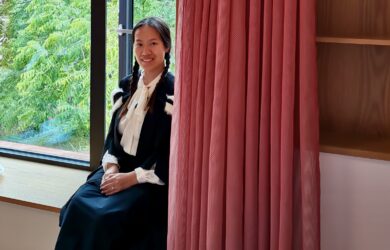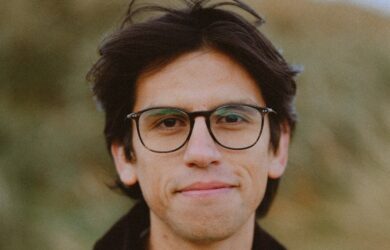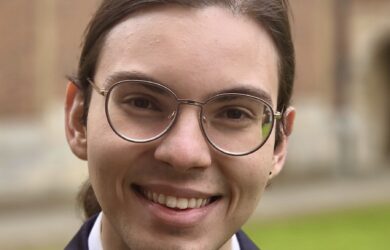
Marie Brunet talks about her work ensuring that nothing important is missed from the dictionary of the human genome.
In the next 10 years, this research will filter through to clinical practice and it is inevitable that it will change the way we do medicine.
Marie Brunet
Marie Brunet’s research focuses on the secrets still hidden in our genomes. She says that despite the fact that we live in an era where getting our genome sequenced is possible, we still don’t know the origin of two fifths of inherited diseases. That is because, as she says, the genome only currently maps the shallow waters of what we need to know to understand such diseases.
Her laboratory in Canada uses deep learning methods to explore genomic data in order to better understand human diseases, with a focus on paediatric cancers and rare diseases. She says: “The outside world is full of wonders and we have much to explore. I like to travel inside our genomes as much as I like to travel the world: exploring, discovering and understanding.”
Childhood
Marie has always had a curious mind. Born in a Paris suburb to a father who is a professor of French, history and geography and a mother who is a special needs educator, she laughs: “Not being good at school was not an option at home.” She always loved school and as a child she would say that she wanted to be a student when she grew up.
Marie [2011] attended local schools in her neighbourhood, which was recognised as a deprived area and given special priority by the government. At her secondary school being academic was not highly valued by her peers so when she took Biology in her last year there were only nine students in the class.
Marie decided she wanted to become a vet so she took two years of the preparatory classes that are necessary to study veterinary science in France. She had long been interested in animals and used to go on regular holidays to visit her maternal grandfather, a farmer, and her uncle, who took over his farm.
Marie would spend the entire time in the fields with her uncle and would leave the table every time the vet visited at meal times so that she could understand what they were doing.
She says she therefore had no Plan B when she left school, but, after her preparatory classes, she covered her bases by sitting the admissions exams needed to study veterinary science as well as the more general ENS exam. She passed them all, but stuck with her original decision to study veterinary medicine. Despite deciding later that she didn’t want to be a vet, Marie doesn’t regret this because she says it gave her a different perspective and way of looking at the kind of fundamental science questions she has gone on to study.
“Natural science students tend to focus first on the small scale then apply that to the large scale whereas a vet starts from the larger scale in order to move towards a likely diagnosis,” she says.
From veterinary science to fundamental research
Marie studied veterinary science for five years at the École nationale vétérinaire d’Alfort [ENVA] and, during that time she worked at a veterinary clinic, including as a nurse and a veterinarian, getting practical experience from the start. As the years went by, however, she began to fall out of love with veterinary practice and in love with the challenge of veterinary medical research. “I could have been a happy vet,” she says, “but I found something I loved even more.”
That love for fundamental research was whetted after Marie came across a flyer for a three-month summer school course in fundamental science for veterinary students that the University of Cambridge was hosting. She was finishing her third year, had no plans for the summer, was starting to realise veterinary science wasn’t entirely what she envisioned and the course looked interesting. It was her first time in Cambridge and her first time doing fundamental research. “I loved it,” she says. “Every day my brain was challenged. Every day I was dealing with a different question.”
Her supervisor was Dr Lesley MacVinish and she took Marie under her wing. “She was an incredible mentor. She made me fall in love with Cambridge and research. It was the first time I had met a person who thought I could do more than I was doing.”
After finishing the course, Marie returned to France, but the experience had changed her sense of where her future lay. In her final year she had to do a thesis. Most of her fellow students opted to do a case study, but she decided she wanted to continue the research she was doing in Cambridge. She was told that was not possible. She had to find a loophole. Dr MacVinish agreed to supervise her. “That meant a lot to me,” she says. Marie won an Erasmus scholarship to Cambridge and did experiments every day over the next months.
Then she returned to France to do her clinical rotation and write up her thesis. Dr MacVinish also encouraged her to apply to Cambridge for a Gates Cambridge scholarship for her PhD and advised her to apply to another laboratory as hers didn’t have funding for a PhD student.
Because she wanted to attend her Gates Cambridge interview in person she failed her clinical rotation and had to appeal to ensure she received her veterinary qualification. She returned to Cambridge in July to work as a research assistant for Dr MacVinish and began her PhD a month early because she feared she would be behind the other students who came from a fundamental science background.
Pharmacology
Marie spent the next four years on her PhD in Pharmacology. She struggled in the first years of her studies into the role of P2X7, a cellular receptor activated by the energy currency of the cell (ATP), in promoting both cellular death and growth, when her attempts to use biochemistry, cellular biology and pharmacology to tackle the subject didn’t bear much fruit.
So, when she realised that she didn’t have enough data for her PhD, Marie decided to turn to bioinformatics. Doing so helped her to meet new people and to build new skills which she worked day and night to teach herself. She would go through the procedures five times or more to verify her results with the help of friends, including fellow Gates Cambridge Scholars. All that hard work paid off: while the first three years of her PhD counted for just 20 pages of her thesis, her last year filled 360.
To relax Marie gave discounted zumba classes at the University Centre, mainly to students. She was also very involved with the Gates Cambridge community, first as social officer of the Gates Cambridge Scholars Council and then as vice president. She says: “Gates Cambridge gave me a sense of belonging and self worth.”
Post-doctoral work
When she finished her PhD, Marie began a post-doctoral fellowship in Biochemistry and Functional Genomics in Xavier Roucou’s laboratory at the University of Sherbrooke in Canada. Professor Roucou, like Dr MacVinish, was a vital mentor figure for Marie, encouraging and empowering her to drive her research forwards.
His laboratory focused on a set of proteins which are encoded by the genome, which had previously been overlooked by researchers. Some researchers said that if the proteins were important they would have been spotted before, but Marie’s argument is that if researchers are not looking for the proteins they won’t find them. She states: “If words are missing from a dictionary and we don’t know they are there, we won’t be looking for them.” She adds that it is important to know what the proteins’ role is, given the need to understand what is being changed when scientists attempt to modify the genome.
Another argument given was that if the proteins did have a role to play it would make genomics very complex. “I love that argument,” says Marie. “Humans are complex. We are made of billions of cells. Mice share 70% of the human genome. What makes them different? We need to embrace our complexity and we can do that so much better using computers.”
OpenProt
Marie did her post-doctoral studies in Professor Roucou’s laboratory from 2016 to 2019 before becoming a research associate there from 2019 to 2021. In July 2021 she was appointed assistant professor and she now has her own laboratory with a focus on pseudogenes, nonfunctional segments of DNA that resemble functional genes, and is trying to understand their role in disease, particularly paediatric cancers and developmental disorders.
Marie works in a clinical department linked to a paediatric unit and continues to use bioinformatics daily so she can conduct large scale studies. Her team and that of Professor Roucou jointly created and lead OpenProt, the first proteogenomic resource supporting a polycistronic annotation model for eukaryotic genomes – which Marie describes as a free dictionary of the genome which draws on Artificial Intelligence to understand where the important information on the genome can be found and whether anything has been missed.
Marie is supported by a Junior 1 career award from the Fonds de Recherche du Québec en Santé (FRQS) until 2025, and her research is funded in part by the Natural Science and Engineering Research Council (NSERC), the Fonds de Recherche du Québec en Nature et Technologies (FRQNT), the Canadian Institutes of Health Research and the FRQS. More recently, she and other leaders in the field of genome annotation have come together to publish a paper in Nature Biotechnology in which they review the state of their field of study and where it should look to make progress.
“I am very proud that we have been able to come together and share information and ideas so we can move the field in the right direction,” she says, adding that so often academia pits researchers against each other and encourages them to be secretive about what they are doing and what they know.
For Marie, who recently gave a TEDx talk, this doesn’t make sense given that there are so many proteins to study and that collaboration can result in progress not just for scientists, but for millions of patients. She says the dictionary of the genome has to be accurate and exhaustive in order for scientists to be able to identify significant mutations and for patients to be treated effectively.
She adds: “In 2016 this field was so new. Few people were asking questions about all the proteins that were missing from our mapping of the genome. People said it was impossible that they were missing important information. Now the message is getting out and more researchers are including this possibility in their research design. In the next 10 years, this will filter through to clinical practice and it is inevitable that it will change the way we do medicine.”
*Picture credit: Youtube.












